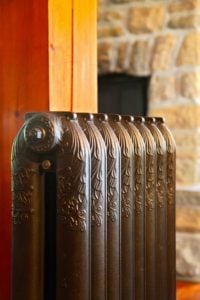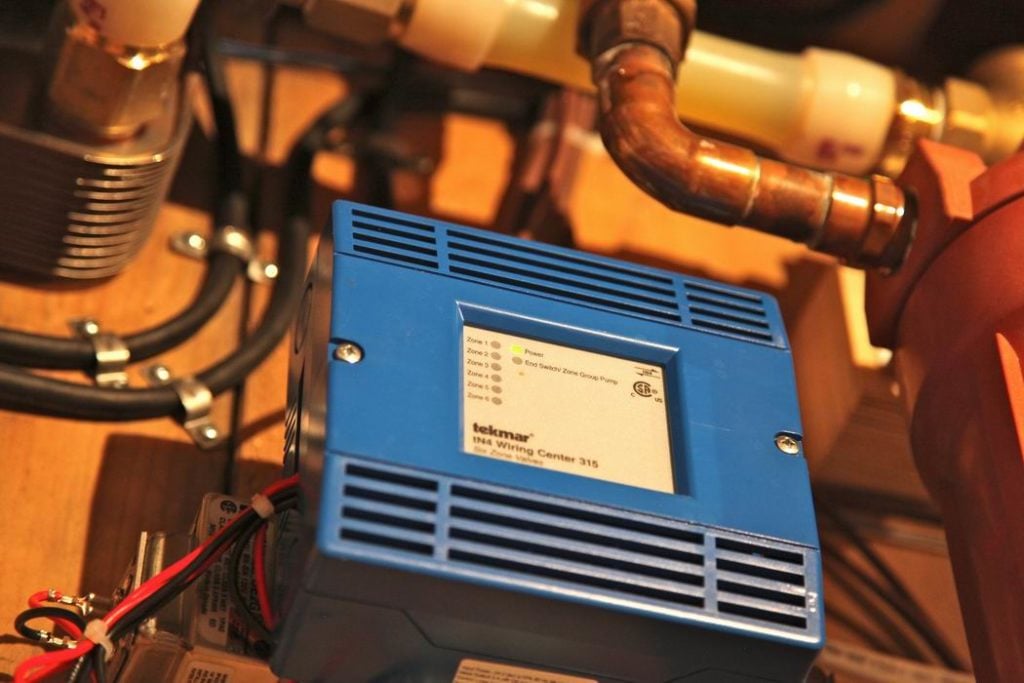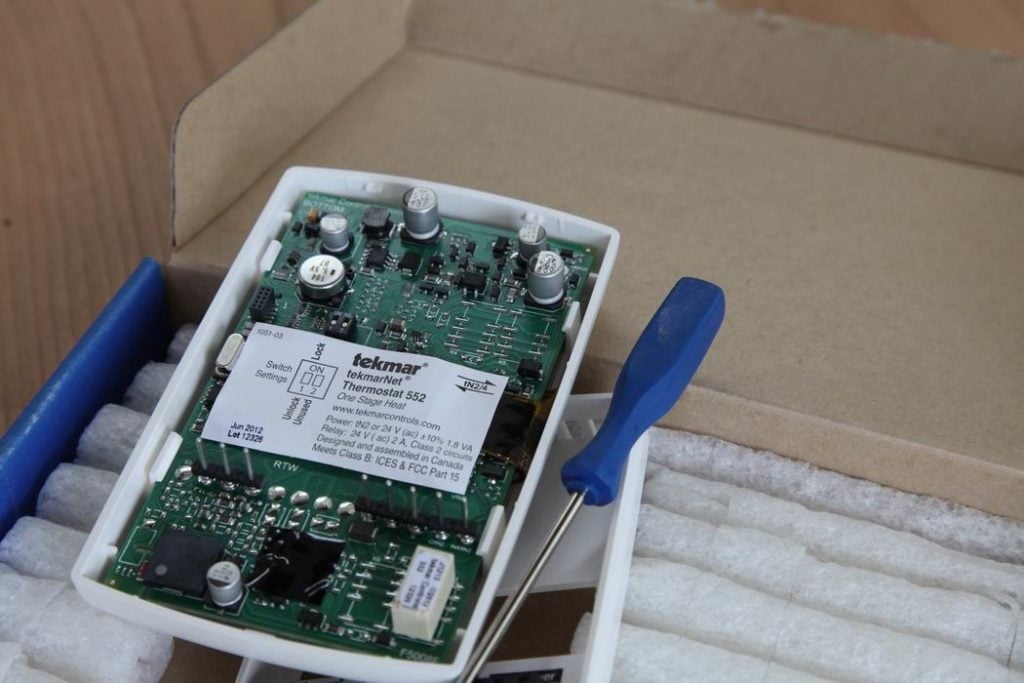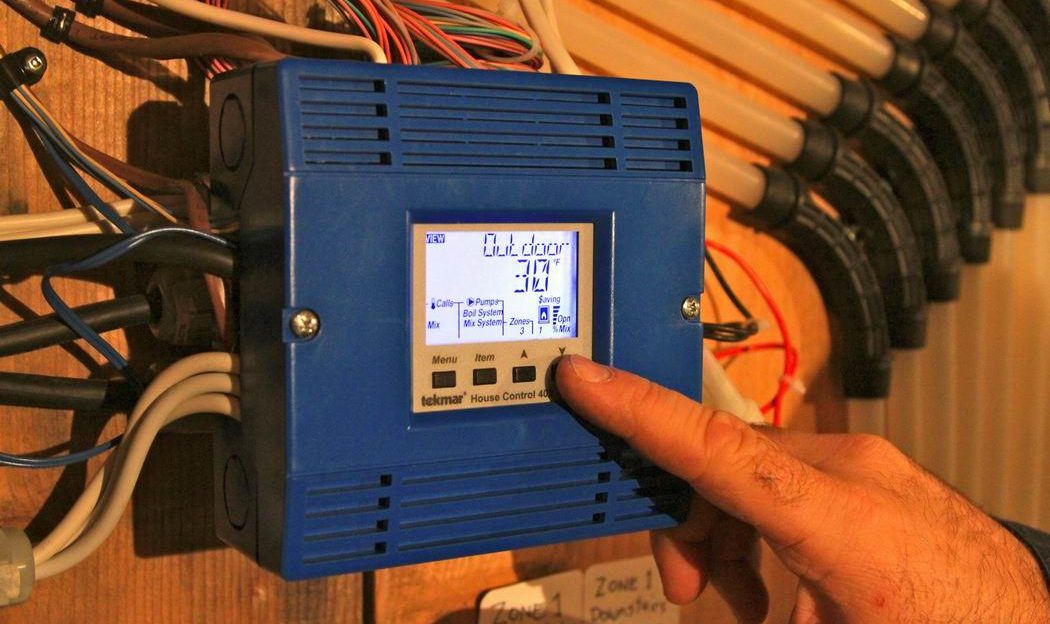There’s more to optimal control of heating systems than just a thermostat that turns heat “on” when it’s too cold, and “off” when temperatures rise. Today’s smartest hydronic heating controls serve this purpose in a way that delivers greater comfort while using less energy. I know because I’ve installed systems like these and I’m particularly impressed with the results.
Hot water radiators and radiant in-floor heating systems are growing in popularity because they deliver more comfortable heat with less noise and airborne dust movement than forced-air systems.
The main drawback with hot water heating is the tendency to over-shoot thermostat settings, making rooms too hot. By the time an ordinary thermostat senses that the room temperature has risen to the set point, there’s still significant thermal energy stored in the hot water that’s in the floor pipes or wall radiators.

Cast iron radiators like this one perform much better when part of a system that includes smart thermostat controls.
While circulator pumps may have shut off, there’s still plenty of residual heat entering the room as the hot water cools off, making room temperatures higher than necessary.
Then there’s also the problem of lag times. It can take longer for hydronic heating systems to bring rooms up to set temperatures because of the high thermal mass of water.
Smart hydronic control systems use three sophisticated features to smooth out room temperatures, but without complication to homeowners. The results are simple and pleasant to live with.
Smart controls can also save as much as 30 per cent in heating costs compared with traditional thermostats used for radiant hydronic heating systems. In fact, without smart controls, many of today’s most efficient condensing boilers can’t live up to their full efficiency potentials.
Smart thermostats: A real-world example

This smart control box is installed near the pumps and valves at the heart of a hot water heating system.
When it comes to home technology, my preference is always for simplicity. That’s why I was reluctant to have anything to do with smart heating controls at first.
What convinced me to go against my instincts and try an installation were the recurring recommendations that I kept hearing from professional installers and homeowners with smart systems. In the end I installed a Canadian system by a west coast company called Tekmar Control Systems. I now see how my initial reluctance was misplaced, and that good engineering makes even complex systems appear quite simple from a user point of view.
How they work

This little device installed underneath a verandah senses outdoor temperatures and feeds this information into a smart thermostat system.
At its most basic level, smart controls harness two powerful ideas — outdoor temperature reset and indoor temperature feedback.
Outdoor temperature reset gathers input from an outdoor temperature sensor to adjust the operating temperature of a boiler or the water flowing through a mixing valve.
Traditional, simple boilers are activated by a thermostat to operate at full temperatures only, leading to lower combustion efficiencies, greater energy losses from the distribution system and wider indoor temperature swings than ideal.
In contrast, if an outdoor temperature reset system senses an outdoor temperature of, say, -3 C, it triggers a boiler temperature to match. Not full-blast output from the boiler, rather just enough heat to get the job done to maximum efficiency. If the thermometer drops to -25 C outside, the system knows it and dials in greater boiler temperatures as required.
Understanding the advantage
This dynamic is very much like what’s involved in responsibly driving your car. If you hammer the gas pedal every time a stop light turns green, blast along at full power all the time, then stand on the brakes hard to stop when the light turns red again, you’ll burn more fuel and wear out your vehicle faster than if you accelerated or decelerated smoothly and gently as conditions warrant.
Standard thermostatic controls are like gas-guzzling, jack rabbit driving. Outdoor temperature reset capabilities, in contrast, allow variable heat output that’s similar to driving more sanely and responsibly.
While some modern boilers come with outdoor temperature reset capabilities from the factory, this isn’t enough on its own. You also need controls with an additional technical feature called indoor temperature feedback.
Think about the car driving example again.
Looking ahead is one of the best ways to save fuel and minimize wear on your car. Anticipating road conditions that you’ll encounter soon, then adjusting your speed, braking and acceleration accordingly, makes sense. Coasting as you see a yellow light in the distance makes more sense than speeding along at the maximum limit and slamming on the brakes when you’re at the red light. In the same way, giving your car some gas slowly when you can see that stopped traffic ahead of you will be moving by the time you get there saves time and money.
Indoor temperature feedback is to hydronic heating control systems what responsible, gentle driving habits are to motorists. The comparison is actually pretty close, and it matters more than you might realize.
Life with a smart thermostat

Smart controls can easily maintain a room temperature within 0.5 degrees by anticipating heating needs.
Living with smart hydronic heating controls is as easy as enjoying exceptionally smooth temperature levels in winter. But if you watch thermostats closely, you’ll see the system actually learning how to make this happen in your particular home.
For the first day or so after I powered up my smart heating controls for the first time, room temperature overshot the thermostat set point by two or three degrees, as is often the case with conventional thermostats controlling hot water heating systems.
But after the smart system gathered information about how fast particular rooms heated up and cooled off, given various outdoor air temperatures, surprising things began to happen.
It wasn’t long before room temperatures became amazingly stable, regardless of outdoor conditions. It’s not unusual for temperatures to remain within 0.5 degrees, even in the spring as outdoor temperatures rise significantly higher over the course of a few hours after sunrise.
Condensing boilers
When it comes to heating systems, condensing boilers have the ability to vary the heat they put out. This is like a car having an accelerator by design.
Older boilers have no “accelerator” and are either “off” or running full blast. The ability that a boiler has to vary heat output does offer efficiency gains, but this is useless if that condensing boiler is only connected to a simple thermostat that just switches “on” or “off”.
Variable calls for heat are needed to make use of condensing boiler action. Many homeowners have been sold on condensing boilers with efficiency levels that promise to transform 96 per cent of the chemical energy of natural gas or propane into heat.
That’s great, but this is true only if that condensing boiler is hooked to a smart control system. Without that this same boiler will probably only hit real-world efficiencies in the mid-80-per-cent range.
Room-to-room communication

This is the inside of a smart thermostat. Despite the apparent complexity, this kind of system is very simple to operate.
There’s one other thing that smart control systems do to lower heating costs. Thermostats from different rooms talk to each other as a network, balancing the various calls for heat depending on what the system has learned about how quickly rooms heat up and cool off, as well as the relative temperature of neighbouring rooms, and the various thermostat settings.
By slightly delaying or advancing calls for heat to minimize the number of times a boiler comes on, greater efficiencies are gained.
It’s impressive to see how smart controls operate in the real world, and to think about the level of intelligence embodied in the circuit boards and algorithms of these systems. Just don’t get the mistaken impression that all this sophistication is for people obsessed with technology. It’s really for anyone who likes to save money and enjoy an exceptionally comfortable home. Isn’t that all of us?
Smart pumps for smart thermostats

This smart circulator pump automatically adjusts to pumping conditions within a hot water heating system.
Circulator pumps are a necessary part of every hydronic heating system because all systems use moving hot water to transfer heat.
What’s not so similar is the different kinds of pumps involved in making that water move. Most simply spin and move water, regardless of whether valves are open or water is allowed to move at all.
It’s wasteful to have pumps trying to dead-head water against closed valves, and that’s one reason smart pumps have been developed. They use internal sensors to monitor the resistance to water flow, automatically adjusting pump output to match.
The most sophisticated smart pump systems I’ve installed are the Grundfos Alpha line. They include three speed settings, plus settings to keep flow rate constant or head pressure constant — whatever you want.
The bottom line is quieter, more elegant operation, plus very low electricity consumption. In tests I’ve run, smart pumps move two to three gallons per minute of water, with a power consumption of only 25 to 30 watts. Conventional circulator pumps often consume 500 per cent more electricity for the same amount of water flow.
Hot water heating with a water heater
You don’t necessarily need a boiler to operate a hot water heating system. The right kind of gas or propane water heater can do an excellent job, while also producing domestic hot water.
Here’s a video that explains the process:






